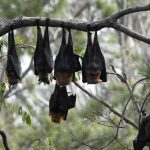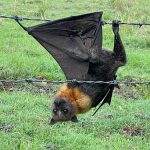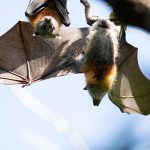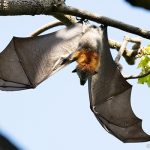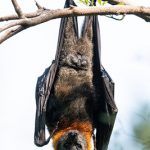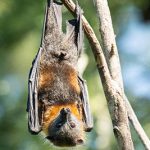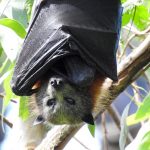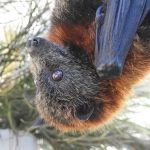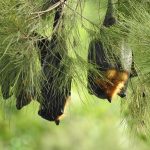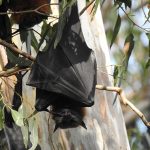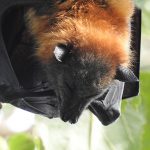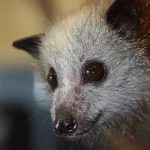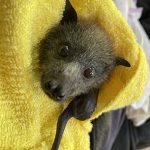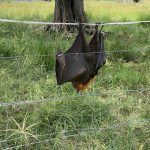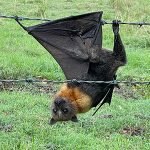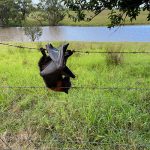GREY-HEADED FLYING-FOX
The Grey-headed Flying Fox: Australia’s Keystone of the Night
As twilight deepens along the eastern coast of Australia, a remarkable spectacle unfolds: thousands of Grey-headed Flying Foxes (Pteropus poliocephalus) rise from their leafy camps and sweep across the darkening sky. Their broad wings, edged in dusk’s last light, carry them silently over forests, rivers, and city parks. Far more than a curious sight, these gentle giants are vital architects of the Australian bush, their nightly journeys shaping the landscape in ways both visible and hidden.
Understanding the Grey-headed Flying Fox
The Grey-headed Flying Fox is Australia’s largest species of bat, with a wingspan stretching over a metre and a thick collar of rusty-orange fur framing its silvery-grey head. By day, they roost in vast, chattering colonies—known as camps—perched high in the trees near water. As the sun sets, the air fills with the leathery flutter of their wings and the soft chorus of their calls, signalling the start of another important night’s work.
| Feature | Description |
|---|---|
| Scientific Name | Pteropus poliocephalus |
| Wingspan | Up to 1.1 metres |
| Weight | 600–1000 grams |
| Conservation Status | Vulnerable (IUCN, Australian EPBC Act) |
Nature’s Night-time Gardeners
The Grey-headed Flying Fox is a keystone species—an organism whose presence is critical to the health and stability of its entire ecosystem. Their nightly foraging for nectar, pollen, and fruit plays an irreplaceable role in the Australian landscape.
Pollination
As these bats feed on the sweet nectar of eucalypt blossoms and banksia flowers, pollen clings to their fur. With each flight to a new tree, they transfer this pollen over great distances, far beyond the reach of bees or birds. Many iconic Australian plants rely on flying foxes for this essential long-distance pollination, especially at night when few other pollinators are active.
Seed Dispersal
Grey-headed Flying Foxes also feast on native fruits and figs, swallowing seeds whole and carrying them dozens of kilometres before dropping them in their droppings. Through this, they help forests regenerate, spreading the next generation of trees well beyond the parent plant.
Maintaining Diversity
By pollinating flowers and dispersing seeds, flying foxes help maintain the dazzling diversity of Australia’s forests—supporting not just plants, but the countless insects, birds, and mammals that depend on these habitats.
The Ripple Effect of a Keystone
Imagine walking beneath a moonlit canopy, the air alive with the scent of eucalypt blossoms and the gentle rustling of wings overhead. Each flying fox is more than just a fleeting shadow; it is a gardener, a pollinator, and a lifeline for the forest. Remove them, and the effects would ripple outwards:
- Trees would flower unvisited, fruits would fall beneath their parent trunks, and the forest’s renewal would falter.
- The rich web of life—from tiny insects to gliding possums—would be weakened.
- The health, resilience, and very future of Australia’s forests would be placed in jeopardy.
Facing Conservation Challenges
Despite their importance, Grey-headed Flying Foxes face serious threats:
- Habitat Loss: Clearing of forests and urban expansion reduce their food and roosting sites.
- Extreme Weather: Heatwaves and drought can cause mass die-offs.
- Human Conflict: Misunderstanding sometimes leads to harm or exclusion from urban areas.
Their vulnerable status is a warning sign for the health of the wider environment.
Protecting Australia’s Flying Foxes
Every Grey-headed Flying Fox is a living connection between the past and future of Australia’s wild places. By protecting them and the forests they serve, we support a chain of life that sustains not only plants and animals, but also the air we breathe and the beauty of the Australian bush.
Ways to Help
- Preserve and restore native habitats.
- Plant flowering trees and shrubs.
- Support wildlife-friendly policies and conservation programs.
Safety Around Flying Foxes
While Grey-headed Flying Foxes are gentle creatures and rarely pose a threat to humans, it’s important to remember that, like all wild animals, they can carry diseases. In Australia, the most significant concern is the Australian Bat Lyssavirus (ABLV), which is similar to rabies and can be transmitted through bites or scratches. For this reason, only trained and vaccinated wildlife carers should handle flying foxes.
What to Do if Bitten or Scratched by a Flying Fox
Should you ever be bitten or scratched by a flying fox, it is crucial to act promptly:
- Wash the Wound Immediately
- Use soap and water to wash the bite or scratch thoroughly for at least 15 minutes. This helps reduce the risk of infection.
- Apply Antiseptic
- After washing, apply an antiseptic solution such as iodine or alcohol if available.
- Seek Medical Attention Straight Away
- Contact your local doctor, hospital, or emergency services as soon as possible. You may need post-exposure treatment to prevent infection from ABLV.
- Do Not Attempt to Handle Wild Bats
- Unless you are a trained and vaccinated wildlife carer, avoid touching or rescuing bats. If you find an injured or distressed flying fox, contact a wildlife rescue organisation for assistance.
Key Takeaway
The Grey-headed Flying Fox is not simply a nocturnal wanderer—it is the keystone that holds together the rich and intricate tapestry of Australia’s forests. By understanding and protecting these remarkable animals, and respecting their space and safety, we ensure that the whisper of their wings continues to carry life and renewal across the land for generations to come.
If you ever encounter a flying fox in need, remember: admire from a distance, and leave their care to the experts. In this way, you help keep both yourself and these vital creatures safe, ensuring the health of Australia’s wild places now and into the future.
Photo Gallery
Sharon: This ‘Aussie Critter’ video was taken at a Maternity Roost where Grey-headed Flying-fox females were swaddling their tiny ‘Pups’ under their wings. This sheltered the Pups from the elements and allowed them to suckle safely. Look closely to see the young.

